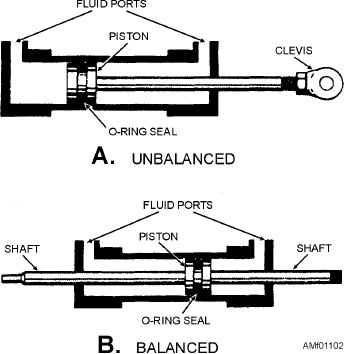
spring is compressed between the rod side of the piston
and the end of the cylinder. Within limits of the
cylinder, the length of the stroke depends upon the
desired movement of the actuated unit.
To retract the piston rod, the directional control
valve is moved to the opposite working position, which
releases the pressure in the cylinder. The spring
tension forces the piston to the left, retracting the
piston rod and moving the actuated unit in the opposite
direction. The fluid is free to flow from the cylinder
through the port, and back through the control valve to
return.
The end of the cylinder opposite the fluid port is
vented to the atmosphere. This prevents air from being
trapped in this area. Any trapped air would compress
during the extension stroke, creating excess pressure
on the rod side of the piston. This would cause sluggish
movement of the piston, and could eventually cause a
Figure 11-2.--Double-acting, piston-type, actuating cylinders.
complete lock, preventing the fluid pressure from
side of the piston creates a force of 6,000 pounds
moving the piston. Seals prevent leakage between the
(2,000 x 3). When the pressure is applied to the rod
cylinder wall and the piston. Hydraulic components
side of the piston, the 2,000-psi pressure acts on 2
use seals or gaskets to prevent leakage between static
square inches (the cross-sectional area of the piston
parts (nonmoving), such as a valve body and a
less the cross-sectional area of the rod) and creates a
hydraulic line fitting. Seals also prevent leakage
force of 4,000 pounds (2,000 x 2). For this reason, this
between dynamic (moving) parts, such as the piston
type of cylinder is normally installed in such a manner
and cylinder wall. The most common seal is an O-ring.
that the blank side of the piston carries the greater load;
Some static seals and all dynamic seals require a
that is, the cylinder carries the greater load during the
backup ring or rings.
piston rod extension stroke.
Double-Acting Actuating Cylinder
A four-way directional control valve is normally
used to control the operation of this type of cylinder.
Most p i s t o n - t y p e a c t u a t i n g c y l i n d e r s a r e
The valve can be positioned to direct fluid under
double-acting, which means that fluid under pressure
pressure to either end of the cylinder, and to allow the
can be applied to either side of the piston to provide
displaced fluid to flow from the opposite end of the
movement and apply force in the corresponding
cylinder through the control valve to return/exhaust.
direction. One design of the double-acting,
The piston of the cylinder shown in view A of
piston-type, actuating cylinder is shown in view A of
figure 11-2 is equipped with an O-ring seal and backup
figure 11-2. This cylinder contains one piston and
rings to prevent internal leakage of fluid from one side
piston rod assembly. The stroke of the piston and
of the piston to the other. Suitable seals and backup
piston rod assembly in either direction is produced by
rings are also used between the hole in the end cap and
fluid pressure. The two fluid ports, one near each end
the piston rod to prevent external leakage. In addition,
of the cylinder, alternate as inlet and outlet, depending
some cylinders of this type have a felt wiper ring
upon the direction of flow from the directional control
attached to the inside of the end cap and fitted around
valve.
the piston rod to guard against the entrance of dirt and
This is referred to as an unbalanced actuating
other foreign matter into the cylinder.
cylinder; that is, there is a difference in the effective
The actuating cylinder shown in view B of figure
working areas on the two sides of the piston. Refer to
11-2 is a double-acting-balanced type. The piston rod
view A of figure 11-2. Assume that the cross-sectional
extends through the piston and out through both ends
area of the piston is 3 square inches and the
of the cylinder. One or both ends of the piston rod may
cross-sectional area of the rod is 1 square inch. In a
2,000-psi system, pressure acting against the blank
be attached to a mechanism to be actuated. In either
11-2

